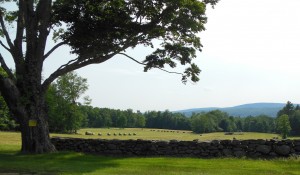 As expected, summer arrived this week, and not a moment too soon. For the diehard bicyclist, our time has just arrived. Yesterday, Debbie and I packed our bikes into the car and headed west to find better aesthetics and less traffic from behind handlebars. Seasonably warm weather brought smiles to our faces and songs to our hearts.
As expected, summer arrived this week, and not a moment too soon. For the diehard bicyclist, our time has just arrived. Yesterday, Debbie and I packed our bikes into the car and headed west to find better aesthetics and less traffic from behind handlebars. Seasonably warm weather brought smiles to our faces and songs to our hearts.
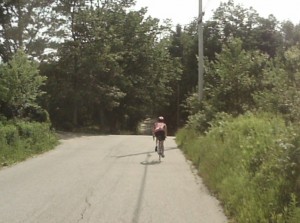 For those who associate metro Boston with Massachusetts, the term “rural Massachusetts” may seem quite foreign, perhaps even oxymoronic. But, alas, there are rural parts in the Commonwealth, actually more of them than are not. The beaten path will not lead you there, which is part of their mystery and appeal.
For those who associate metro Boston with Massachusetts, the term “rural Massachusetts” may seem quite foreign, perhaps even oxymoronic. But, alas, there are rural parts in the Commonwealth, actually more of them than are not. The beaten path will not lead you there, which is part of their mystery and appeal.
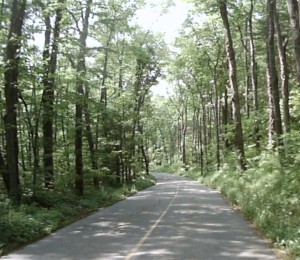 We enjoyed many of nature’s pleasantries along our 58-mile stretch of road from Rutland to Ware and back. Two weeks ago, Debbie had experienced this “metric century” as part of the “King’s Tour of the Quaddin” bicycle event. Roughly 200 cyclists took advantage of this ride, sponsored by Seven Hills Wheelmen, on a Sunday morning to enjoy some of Massachusetts’ less traveled roads.
We enjoyed many of nature’s pleasantries along our 58-mile stretch of road from Rutland to Ware and back. Two weeks ago, Debbie had experienced this “metric century” as part of the “King’s Tour of the Quaddin” bicycle event. Roughly 200 cyclists took advantage of this ride, sponsored by Seven Hills Wheelmen, on a Sunday morning to enjoy some of Massachusetts’ less traveled roads.
Yesterday, despite periodic sightings of dairy cows, roosters, and goats, the roadsides were lined with poplar stands and brush, often canvassing us from the sun as we seesawed up and down the rolling hills. Over 3,500 feet of elevation gain and tired bodies reminded us we were still in New England.
Another reminder of New England were the village greens and accompanying Congregational churches of small towns like Barre, Hardwick, Ware, New Braintree, and Oakham. The impressive steeples and white edifices of these churches now stand as mere symbols of a day gone by when church life was integral to the fabric of these towns, and the moral underpinning of a larger American society. In a simpler time when local community was celebrated over virtual, technology-based community, they acted as the vibrant centerpiece of life. But nowadays, they seem more like museums, where secular community activities may still find a home. And at least on this day, one was relegated to hosting a tag sale. Clearly, there was more activity at the local package store.
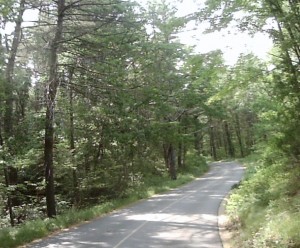 Another form of change in that area has had a more sustaining impact, helping to preserve the rural–and pristine–nature of the land we traveled. We passed through an area of historical significance, not just for those in the vicinity, but also for those who live in, or visit, greater Boston.
Another form of change in that area has had a more sustaining impact, helping to preserve the rural–and pristine–nature of the land we traveled. We passed through an area of historical significance, not just for those in the vicinity, but also for those who live in, or visit, greater Boston.
In the 1930’s, this region was converted from rural, small-town, New England to an engineering marvel of its day, complete with water, the sounds of nature, and eventually trees and bushes. Twenty-five hundred residents of four towns were displaced from their homes–and their homeland–for the greater good. The towns of Dana, Greenwich, Enfield, and Prescott are no more, casualties of the progress of the day, and a few million thirsty residents 65 miles to their east. A decade of politicking, rasing structures and vegetation, and scorching the land converted the Swift River Valley into the largest source of drinking water for Boston and fifty of its neighboring communities.
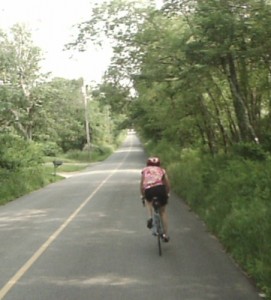 It took nature seven years to fill 39 square miles with over 400 billion gallons of water. Then, in 1946, the spigot was opened and clean water from Quabbin Reservoir began servicing eastern Massachusetts. (Information courtesy of WBUR’s Inside Out Documentaries, and their piece “Haunting the Quabbin.”)
It took nature seven years to fill 39 square miles with over 400 billion gallons of water. Then, in 1946, the spigot was opened and clean water from Quabbin Reservoir began servicing eastern Massachusetts. (Information courtesy of WBUR’s Inside Out Documentaries, and their piece “Haunting the Quabbin.”)
Ironically, yesteryear’s controversial development has preserved, and some might argue has even enhanced, the beauty of this piece of rural Massachusetts. Because of the need to protect its drinking water, development in this region is limited. As a result, trees are plentiful, traffic is sparse, and nature reigns. Today’s cyclist is a clear winner in the Quabbin project.
